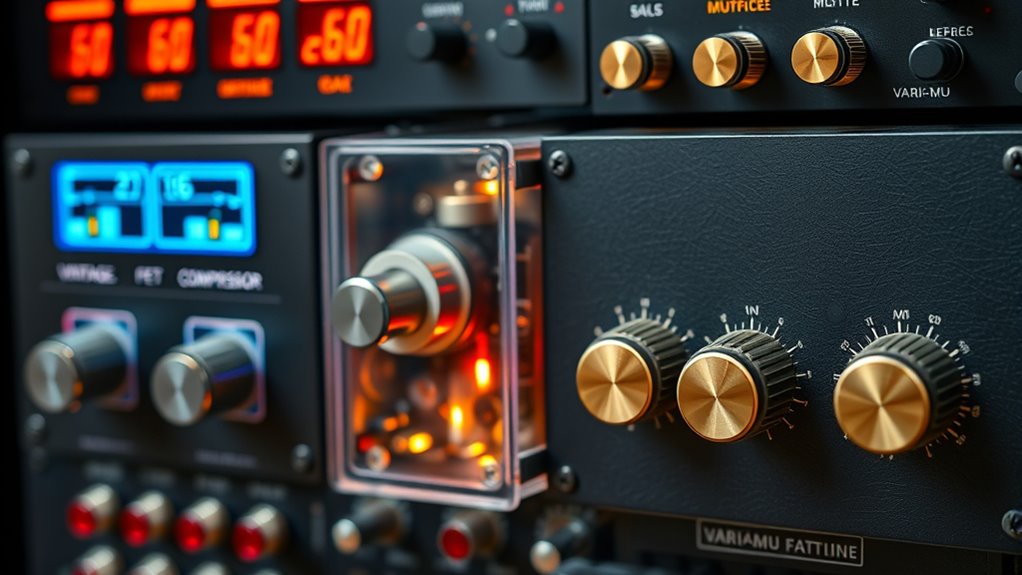Understanding compression types like VCA, FET, Opto, and Vari-Mu helps you shape your sound effectively. VCA compressors respond quickly and are versatile, perfect for controlling peaks without changing tone. FET units mimic tube feel with aggressive, fast attacks that catch transients well. Opto compressors offer smooth, natural compression with slower response, ideal for vocals. Vari-Mu designs provide warm, musical tone with slower, more gentle compression. Keep exploring these options to master their unique traits and application tricks.
Key Takeaways
- VCA compressors offer precise, fast response ideal for controlling peaks without affecting overall tone.
- FET compressors mimic tube sounds with aggressive, fast attack times suitable for transient control.
- Opto compressors provide smooth, natural compression with slower attack and release, ideal for vocals and acoustic instruments.
- Vari-Mu compressors deliver warm, musical compression with longer attack and release, emphasizing tone and sustain.
- Each type’s unique response characteristics make them suited for specific mixing and mastering applications.

Have you ever wondered how large files are reduced to save space or speed up transmission? The same principle applies when you’re working with audio compression. Compressors control the dynamic range of sound, making loud parts quieter and quiet parts louder, creating a balanced and polished mix. Different compressor types achieve this with unique characteristics, but all rely on key parameters like threshold adjustment, attack, and release to shape how the compression responds to audio signals.
VCA (Voltage Controlled Amplifier) compressors are known for their precision and versatility. They respond quickly to incoming signals, making them ideal for controlling loud peaks without affecting the overall tone. When setting a VCA compressor, you adjust the threshold so it activates only when signals exceed a certain level. The attack and release times determine how rapidly the compressor responds—attack controls how fast it kicks in after the threshold is crossed, and release dictates how quickly it stops compressing once the signal dips below the threshold. This precise control allows you to smooth out the audio dynamically, maintaining clarity without overly squashing the sound.
FET (Field Effect Transistor) compressors mimic the behavior of tube compressors but with a more aggressive response. They’re characterized by their fast attack times, which makes them excellent for catching sudden transients like drum hits. When you’re working with a FET compressor, setting the threshold correctly is vital: too low, and you’ll squash the sound excessively; too high, and the compressor won’t engage enough. The attack and release settings must be fine-tuned to preserve the punch of the transient while controlling the overall dynamics. A fast attack will tame sharp peaks, and a well-adjusted release will ensure the compression feels natural and musical.
Opto compressors use a light-dependent resistor (LDR) to control gain reduction. They tend to have slower attack and release times, giving a more transparent and smooth compression. When adjusting an opto compressor, the threshold determines when the light inside the unit dims enough to activate compression. Attack and release times are more gradual, so they’re ideal for vocals and acoustic instruments where you want a gentle, natural sound. Adjusting these parameters carefully guarantees the compressor responds smoothly to the dynamics without causing unnatural pumping or breathing effects. Their slower response often results in a more musical and less aggressive compression style.
Vari-Mu compressors are based on vintage tube designs, offering a warm, musical compression. They work more slowly, with longer attack and release times, making them perfect for gentle leveling. Threshold adjustment here is about setting the point where the tube’s gain reduction kicks in, while attack and release are set to allow the natural decay of the instrument or voice. This type of compression is less about catching transient peaks instantly and more about shaping the overall tone and sustain, with the parameters working together to produce a smooth, cohesive sound.
Each compressor type offers a different flavor and response, but understanding how to manipulate threshold adjustment, attack, and release is essential to harnessing their full potential.
Frequently Asked Questions
How Do I Choose the Best Compressor Type for Vocals?
When choosing a compressor for vocals, consider its compression characteristics and how they match your desired sound. If you want transparent, precise control, a VCA compressor works best. For a warmer, more musical feel, opt for a Vari-Mu. If you prefer a faster, punchier response, FET compressors are ideal. An opto compressor suits gentle, natural compression. Match the compressor to your vocal style and the vibe you’re aiming for to guarantee the best results.
Can Multiple Compressor Types Be Used Together in a Mix?
Using multiple compressor types together is like painting with different brushes; it adds richness and complexity to your mix. You can blend parallel compression to retain punch and control dynamics, while multi-band compression targets specific frequency ranges for precision. This approach allows you to tailor your sound, balancing transparency and punch. Combining compressors creates a more polished, professional vocal sound, giving your mix depth and clarity that single compression can’t achieve alone.
What Are Common Mistakes When Setting Compressor Attack and Release?
You might make mistakes with attack timing and release settings by setting them too fast or too slow. Fast attack can squash transients, making the sound dull, while slow attack lets peaks through too much. For release, setting it too short causes pumping, and too long can make compression feel sluggish. Experiment with attack and release to find a natural balance, ensuring the compressor enhances your sound without introducing unwanted artifacts.
Do Different Compressor Types Impact Audio Transparency?
Think of your compressor as a paintbrush, where the circuit design influences the color it leaves on your sound. Different compressor types impact audio transparency: VCA compressors are precise, often preserving clarity, while FETs add a certain warmth or edge. Opto and Vari-Mu compressors tend to produce more musical, natural compression, but can introduce subtle audio coloration. Your choice shapes the transparency and character of your final mix.
Are Certain Compressor Types Better for Live Versus Studio Recordings?
Certain compressor types suit live or studio recordings better, depending on their durability and maintenance needs. For live settings, opto and VCA compressors are often preferred because they’re reliable and handle wear well. In the studio, FET and Vari-Mu compressors shine for their tonal qualities but may require more maintenance. Choose based on your setup’s durability needs and how often you’re willing to service your gear to guarantee maximum performance.
Conclusion
Now that you know about VCA, FET, opto, and vari-mu compression, it’s like discovering different keys to open perfect sound. Each type naturally complements your musical style, revealing surprises along the way. You might find that mixing these compressors creates unique textures, almost by coincidence. So, explore freely—sometimes, the best sound comes when you least expect it, turning technical choices into happy accidents that elevate your music in unexpected ways.










